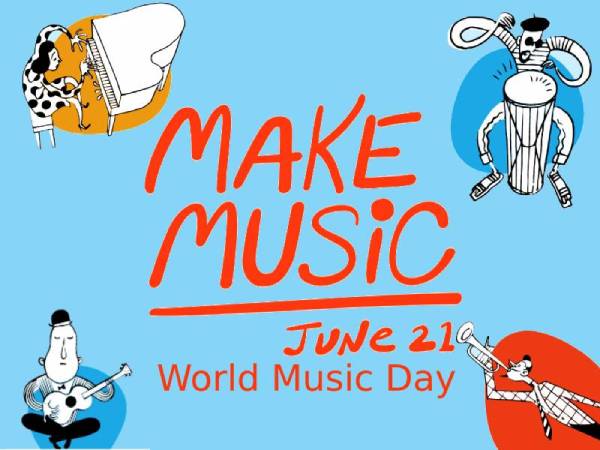
By Anand Parthasarathy
June 18 2023: The idea of a World Music Day started 41 years ago. In 1982, the French Ministry of Culture dreamed of a day -- June 21 --when music would be performed for free world-wide, in streets, parks, shops – everywhere. The idea caught on and today over 120 countries including India witness free music concerts in unlikely locations.
The way we listen to music has changed dramatically in recent years. Remember the day when you put on a ‘gramophone record’ and the family sat around to hear? You removed the record from its sleeve, opened the cover of the record player, placed the record carefully on the platter, set the stylus on the record, switched on the player and waited for the crackle that told you the music was about to start.
From 1912, when it became commercially available, it was a 12-inch, 78 rpm record, with just 3-5 minutes on each side. Then came the long play record, with the 33 rpm version emerging as the standard and giving you nearly a half hour on each side.
That was an age ago
Today, people consume music on the go, from earphones stuck to their mobile phones or from tiny digital music players, while working, walking, exercising. They stop and start at will, shuffle the tracks and jump the dull parts.
Tape recorders were launched in 1935 in Germany, but the bulky instruments never became a mass consumer product.
Players shrunk in size when vinyl records gave way to the cassette tape players: the Dutch company Philips launched it in 1963. Table top cassette players allowed you to both play and record – a huge advance. Radio-cum-cassette players, which became very popular in India in the early 1970s, made recording the fare on Vividh Bharathi and other popular channels very easy.
True portability came with Sony’s launch of the iconic Walkman in 1979. You could slip in a cassette and listen through earphones and suddenly music was untethered .
Sony has updated the Walkman over the years: in 2015 it had become an all-digital music storage and play device. As recently as 2023, it launched the Walkman NW-ZX707 with the best sound reproduction till date and a WiFi connection for direct download. It costs just under Rs 70,000
Cassette tape to CD
To return to the chronology of music players
Capacity on each cassette tape varied, similar to an LP record – remember C-60, C-90, C-120 and other versions? Snarling tape was a regular hassle – and the solution had to wait till 1982-83 when Sony and Philips jointly invented the 4.7 inch compact disk or CD.
This remained the dominant form for the distribution of recorded music right up to the first decade of this century, with the DVD Digital Video Disk or DVD adding more playing time to the CD and making movie distribution on a single disk possible.
But the Internet and the mobile phone changed all that. Music had become all-digital. It could be downloaded at will for free or a fee – and stored directly on a phone or a USB stick, creating personal collections, rather than what a music publisher chose to compile
In 2010, Times Music pioneered streaming music in India under the Gaana brand -- no need to download and store music, you paid a subscription and streamed the music of your choice, live to any device you owned. In the decade since then, Audio OTT or Over The Top music has exploded to gain a total customer based of 460 million in India according to Redseer, with major players like Gaana, JioSaavn, Hungama, Audible and Spotify each offering a repertoire of more than 50 million music tracks. Deloitte predicts that the Indian audio OTT market will be worth $3.5 billion by 2025, making it one of the world’s biggest streamed music markets.
People tend to have old collections of cassettes and CDs and want to access the contents . The need to access legacy collections led to versatile crossover products like the Philips Sound Machine which was the first to offer in a single device the ability to hear music on cassette, CD, USB stick or FM radio. It also allowed you to ‘rip’ the CD or cassette and store the contents on a USB stick – all for under Rs 5000. But it is no longer in production – a signal that younger customers today, who overwhelmingly patronize OTT audio, have no connect with these old systems
Unlikely Vinyl revival
In one of the unlikeliest developments in the music world, The Recording Industry Association of America (RIAA) reported last year that for the time in 3 decades, the sale of vinyl records, long thought to be extinct, outsold CDs – 41 million to 33 million and accounted for 70% of all music sold in physical form.
That is because many purists still swear by the quality of sound from the analogue recording on a vinyl disk compared to its digitized version. DJs or disk jockeys for example, have also sworn by vinyl and a record player is still a key accessory of such music presenters, even though they may carry their repertoire on a hard disk.
Covid too, gave people more time at home and many old timers dusted off their 50 year old collection of ‘gramophone’ records and tried to shop on Amazon for a suitable player. And this revival has also allowed owners to sell their LP collections on online sites, for many times the price for which they bought them.
The resurgence of Vinyl today is one of those rare developments in the history of recorded music that reminds us that old adage: Old is indeed Gold.
Illustrations for this article can be found here
This article has appeared in Swarajya